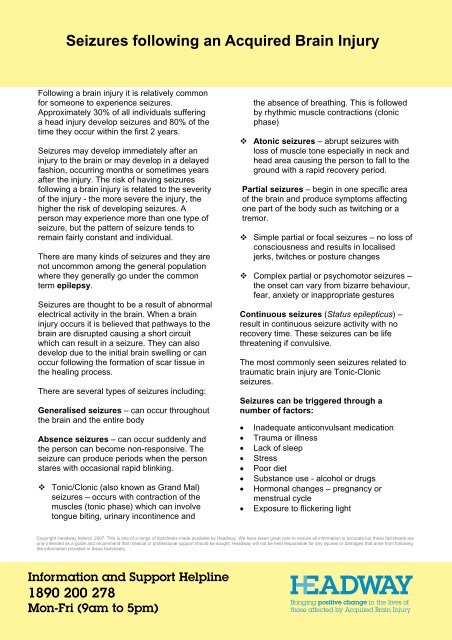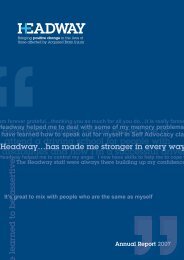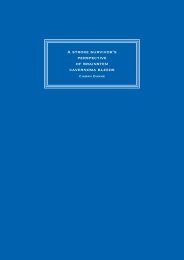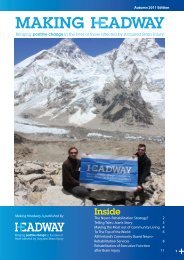Seizures following an Acquired Brain Injury - Headway
Seizures following an Acquired Brain Injury - Headway
Seizures following an Acquired Brain Injury - Headway
You also want an ePaper? Increase the reach of your titles
YUMPU automatically turns print PDFs into web optimized ePapers that Google loves.
<strong>Seizures</strong> <strong>following</strong> <strong>an</strong> <strong>Acquired</strong> <strong>Brain</strong> <strong>Injury</strong><br />
Following a brain injury it is relatively common<br />
for someone to experience seizures.<br />
Approximately 30% of all individuals suffering<br />
a head injury develop seizures <strong>an</strong>d 80% of the<br />
time they occur within the first 2 years.<br />
<strong>Seizures</strong> may develop immediately after <strong>an</strong><br />
injury to the brain or may develop in a delayed<br />
fashion, occurring months or sometimes years<br />
after the injury. The risk of having seizures<br />
<strong>following</strong> a brain injury is related to the severity<br />
of the injury - the more severe the injury, the<br />
higher the risk of developing seizures. A<br />
person may experience more th<strong>an</strong> one type of<br />
seizure, but the pattern of seizure tends to<br />
remain fairly const<strong>an</strong>t <strong>an</strong>d individual.<br />
There are m<strong>an</strong>y kinds of seizures <strong>an</strong>d they are<br />
not uncommon among the general population<br />
where they generally go under the common<br />
term epilepsy.<br />
<strong>Seizures</strong> are thought to be a result of abnormal<br />
electrical activity in the brain. When a brain<br />
injury occurs it is believed that pathways to the<br />
brain are disrupted causing a short circuit<br />
which c<strong>an</strong> result in a seizure. They c<strong>an</strong> also<br />
develop due to the initial brain swelling or c<strong>an</strong><br />
occur <strong>following</strong> the formation of scar tissue in<br />
the healing process.<br />
There are several types of seizures including:<br />
Generalised seizures – c<strong>an</strong> occur throughout<br />
the brain <strong>an</strong>d the entire body<br />
Absence seizures – c<strong>an</strong> occur suddenly <strong>an</strong>d<br />
the person c<strong>an</strong> become non-responsive. The<br />
seizure c<strong>an</strong> produce periods when the person<br />
stares with occasional rapid blinking.<br />
Tonic/Clonic (also known as Gr<strong>an</strong>d Mal)<br />
seizures – occurs with contraction of the<br />
muscles (tonic phase) which c<strong>an</strong> involve<br />
tongue biting, urinary incontinence <strong>an</strong>d<br />
the absence of breathing. This is followed<br />
by rhythmic muscle contractions (clonic<br />
phase)<br />
Atonic seizures – abrupt seizures with<br />
loss of muscle tone especially in neck <strong>an</strong>d<br />
head area causing the person to fall to the<br />
ground with a rapid recovery period.<br />
Partial seizures – begin in one specific area<br />
of the brain <strong>an</strong>d produce symptoms affecting<br />
one part of the body such as twitching or a<br />
tremor.<br />
Simple partial or focal seizures – no loss of<br />
consciousness <strong>an</strong>d results in localised<br />
jerks, twitches or posture ch<strong>an</strong>ges<br />
Complex partial or psychomotor seizures –<br />
the onset c<strong>an</strong> vary from bizarre behaviour,<br />
fear, <strong>an</strong>xiety or inappropriate gestures<br />
Continuous seizures (Status epilepticus) –<br />
result in continuous seizure activity with no<br />
recovery time. These seizures c<strong>an</strong> be life<br />
threatening if convulsive.<br />
The most commonly seen seizures related to<br />
traumatic brain injury are Tonic-Clonic<br />
seizures.<br />
<strong>Seizures</strong> c<strong>an</strong> be triggered through a<br />
number of factors:<br />
• Inadequate <strong>an</strong>ticonvuls<strong>an</strong>t medication<br />
• Trauma or illness<br />
• Lack of sleep<br />
• Stress<br />
• Poor diet<br />
• Subst<strong>an</strong>ce use - alcohol or drugs<br />
• Hormonal ch<strong>an</strong>ges – pregn<strong>an</strong>cy or<br />
menstrual cycle<br />
• Exposure to flickering light<br />
Copyright <strong>Headway</strong> Irel<strong>an</strong>d, 2007. This is one of a r<strong>an</strong>ge of factsheets made available by <strong>Headway</strong>. We have taken great care to ensure all information is accurate but these factsheets are<br />
only intended as a guide <strong>an</strong>d recommend that medical or professional support should be sought. <strong>Headway</strong> will not be held responsible for <strong>an</strong>y injuries or damages that arise from <strong>following</strong><br />
the information provided in these factsheets.<br />
Information <strong>an</strong>d Support Helpline<br />
1890 200 278<br />
Mon-Fri (9am to 5pm)
Diagnosing <strong>Seizures</strong> <strong>an</strong>d Epilepsy<br />
To confirm that a person is having seizure<br />
activity, the doctor will need to conduct a<br />
number of tests.<br />
A blood test will check the general health of a<br />
person <strong>an</strong>d exclude <strong>an</strong>y subst<strong>an</strong>ces such as<br />
drugs that may cause a seizure; a brain sc<strong>an</strong><br />
will reveal <strong>an</strong>y structural cause for the seizure<br />
<strong>an</strong>d <strong>an</strong> Electroencephalogram (EEG)<br />
measures the electrical activity of the brain<br />
surface.<br />
Seizure Treatment<br />
The main treatment for seizures is<br />
<strong>an</strong>ticonvuls<strong>an</strong>t medication which acts to<br />
prevent the spread of abnormal electrical<br />
activity from one nerve cell to <strong>an</strong>other. There<br />
are a number of different drugs on the market,<br />
but the key is finding the one that is right for<br />
you.<br />
When starting a course of medication it may<br />
take several days for the drug level to build up<br />
to a level in the bloodstream at which it<br />
becomes effective. In order for <strong>an</strong>ticonvuls<strong>an</strong>ts<br />
to work the prescribed dose needs to be taken<br />
consistently according to your doctor’s<br />
instruction <strong>an</strong>d blood tests will be taken at<br />
regular intervals to check the drug level in the<br />
bloodstream.<br />
What to do when a person has a seizure<br />
• Stay calm – if you p<strong>an</strong>ic the person may<br />
become agitated<br />
• Make sure <strong>an</strong>y tight clothing around the<br />
neck is loosened, including necklaces<br />
• Move d<strong>an</strong>gerous objects away from the<br />
person<br />
• Check that nothing is obstructing their<br />
breathing<br />
• Put something soft under the person’s<br />
head to prevent injury.<br />
• Following the convulsion, turn the person<br />
onto their left side <strong>an</strong>d into the recovery<br />
position.<br />
• Call <strong>an</strong> ambul<strong>an</strong>ce if the convulsion lasts<br />
longer th<strong>an</strong> five minutes, if the person is<br />
having repeated convulsions, is hurt or the<br />
seizure is different in <strong>an</strong>y way.<br />
• Remain with them until they have fully<br />
recovered.<br />
• Using a gentle <strong>an</strong>d reassuring voice repeat<br />
instructions to the individual until you are<br />
certain that they have understood.<br />
• If the person suddenly moves away,<br />
accomp<strong>an</strong>y them until they respond – if the<br />
person w<strong>an</strong>ders gently guide them<br />
• Do not place <strong>an</strong>ything in the person’s<br />
mouth.<br />
• Do not restrict <strong>an</strong>y convulsive movements<br />
as you may hurt the person or yourself.<br />
• Do not try to rouse the person.<br />
• Do not restrain the person unless there is<br />
immediate physical d<strong>an</strong>ger e.g. fire, water<br />
or traffic.<br />
• Do not move the person unless s/he is in a<br />
d<strong>an</strong>gerous place e.g. in the road or at the<br />
top of a stairs<br />
• Do not add to the person’s distress by<br />
saying “what a fright you gave us” etc<br />
• Do not give the person <strong>an</strong>ything to drink<br />
until you are sure that they are fully awake.<br />
Copyright <strong>Headway</strong> Irel<strong>an</strong>d, 2007. This is one of a r<strong>an</strong>ge of factsheets made available by <strong>Headway</strong>. We have taken great care to ensure all information is accurate but these factsheets are only<br />
intended as a guide <strong>an</strong>d recommend that medical or professional support should be sought. <strong>Headway</strong> will not be held responsible for <strong>an</strong>y injuries or damages that arise from <strong>following</strong> the<br />
information provided in these factsheets.<br />
Information <strong>an</strong>d Support Helpline<br />
1890 200 278<br />
Mon-Fri (9am to 5pm)








